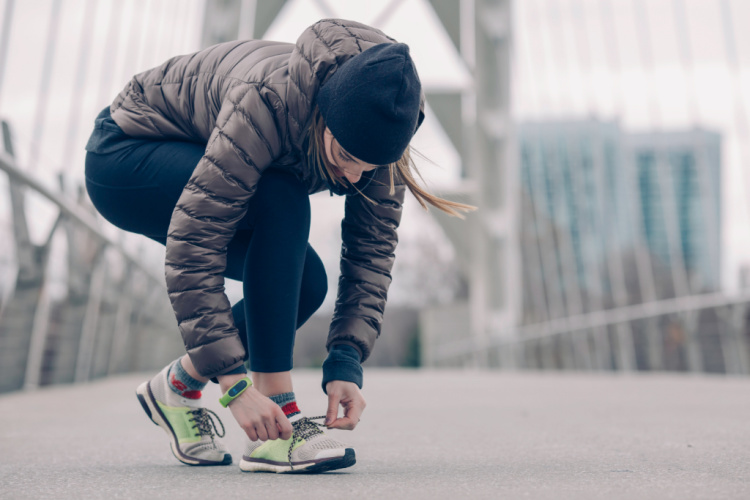9 Trusty Tips for Exercising Safely in Cold Weather
Mar 8, 2021

Restrictions from the COVID-19 pandemic have very likely impacted access to your favorite gym or fitness center, with many having to reduce capacity or close altogether. That means that one place you may have to go to get in a fitness routine or long walk is outside — something that can be tough to do during cold, winter weather, snow or rain. It also can be risky if not done right.
In a recent blog post, Dr. Gabe Mirkin, a fitness guru, longtime radio host and sports medicine doctor with more than 50 years of practice, outlined several things to be aware of when it comes to being outside in cold weather.
“This winter is more dangerous than previous winters because cold weather increases your risk for COVID-19, since it increases the time that people spend indoors where the virus can accumulate in the air,” Dr Mirkin wrote.
The chances of getting COVID outside, however, are much slimmer. But, doing so safely is critical. Dr. Mirkin outlined cold weather risks that include elevated blood pressure and cholesterol, increased clotting, exercise-induced asthma, chest pain, hypothermia and frostbite. Thankfully, there are ways you can do it safely, and embarking on a fitness plan is an important step to take when it comes to a healthy lifestyle. Just be sure to talk to your doctor first before exercising to make sure it fits with your individual health level.
Below are 9 trusty tips for exercising safely in cold weather.
1) Pick the right clothing.
It’s not just about being warm — it’s about staying dry. The last thing you want to do is wear cotton clothing that soaks up moisture and leaves your skin feeling wet, something that may cause you to give up on your exercise early, or worse, lead to hypothermia or frostbite.
Choose clothing made of fabrics like polyester or nylon, and consider purchasing underclothing and long johns made of materials that keep in the heat.
2) Layers are your friend.
Depending on how cold it is, you’re going to want to add 2-3 layers of clothing to trap warmth and stave off snow, rain and cold. Start with your base layer, then add a warm fleece or coat. If it’s really cold, choose the fleece and the coat.
Same goes for your legs. Start with an underlayer like polyester leggings, then put on long workout pants.
And don’t forget your ears, hands and feet, which are especially prone to frostbite! Choose warm, winter-friendly gloves and 1-2 pairs of warm socks to ensure they stay heated. Ears have a particular knack for getting cold as well, so wear ear muffs, an ear-covering headband or a hat.
3) Hydrate, hydrate, hydrate!
Don’t make the mistake of thinking just because it’s winter and cold, you don’t need to drink as much water. Water is not only key to ensuring your muscles operate better during fitness, but it also helps keep your skin from drying out in the cold, dry winter air.
4) Plan your route.
Think about where you’re going to walk or run before you go. Is there a lot of ice or unpaved snow? You might even consider driving it first to ensure the way is clear and you can move on it safely.
If you do head out without checking first, do your best to stay away from icy spots, working to step on pavement or concrete that’s clear of snow or has been salted. This is important to ensure you aren’t trying to run or walk on icy surfaces that may lead to a fall or injury.
.jpg)
5) Get the blood flowing before you head out.
Warm-ups are important with any fitness routine, and that definitely includes before one that involves being outside in cold weather. Choose a dynamic warm up to get the blood flowing to your muscles and increase your core body temperature.
This will not only help decrease the risk of injury, but will also warm up your body ahead of being outdoors in the cold.
6) Consider covering your mouth.
Proper breathing is one of the most important parts of exercise. Taking deep, controlled breaths while moving helps increase oxygen intake, which in turns improves muscle exertion.
But breathing in cold, dry winter air also tends to lead to a narrowing of the airway passages. Wrapping a thin scarf around your mouth can help because it helps trap water vapor while you’re breathing, which naturally adds a bit of humidity.
7) Pay attention to the wind.
If it’s a windy day, start your workout by facing the wind. As you exercise, you will likely start to sweat, which will cause you to lose body heat. By starting facing the wind, it ensures you’re not fighting it on the way back when your body is at the losing-body-heat stage.
8) Take those extra layers off as you go.
Once you start moving, your body will inevitably warm up. Be sure to take off layers if they feel too warm. You can tie them around your waist or hold them, and this ensures you don’t get too sweaty, which can increase the risk of dehydration. If you start to get cold again, you can always pop them back on.
9) Cool down.
Like any exercise routine, a cool-down is important to reduce the risk of injury and soreness. At the end of your workout, take 5-10 minutes to do some deep breathing and stretching, allowing your heart rate to normalize. Also remember to take small sips of water to rehydrate your body.
Exercising in the cold doesn’t have to be unpleasant. In fact, many people prefer it! It’s all about preparing and taking the necessary steps to make it a good, safe experience.
What’s your favorite outdoor fitness routine? Share it in the comments below!
------------------------------------------------------------------------------------
Author: Caitlin H
Diet-to-Go Community Manager
Caitlin is the Diet-to-Go community manager and an avid runner. She is passionate about engaging with others online and maintaining a healthy, active lifestyle. She believes moderation is key, and people will have the most weight loss success if they engage in common-sense healthy eating and fitness.










